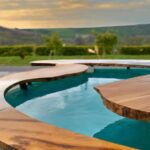By
Berber typically refers to a woven overlay, usually light in color with flecks of darker colors (generally brown or gray), and has a distinctive loop pile that binds to the backing and is left uncut. It takes cues from the North African Berber people’s specific weaving technique. However, the name Berber remained, and today, its loop cover form is more frequently mentioned than the color.
The Benefits of Berber Carpet
Let’s look at its excellent benefits and know why you should install floor coverings in your room, workplace, or home.
Durability and longevity
Berber overlays are long-lasting and ideal for high-traffic areas in homes and offices because the loop pile is tough to grab and tear out. This carpeting can last a long time. Properly maintaining your carpeting will extend its lifespan significantly. While the cost of the sheet used with this carpeting increases with quality, you can expect a corresponding increase in its durability and value. The sheet’s cost will also increase with quality, but you will get the actual return on investment.
Versatility and Style
Berber overlays are not limited to vintage or trendy styles. You can install the gray sheet or any other color of Berber in your home, office, or workplace because of the elegant look and seamless fitting.
Comfort and Insulation
Berber overlaying’s looped shape provides a more cushioned and “bouncy” underfoot feel that many consumers associate with a high-quality coating. Berber sheets offer thermal insulation and resistance. It retains warm air for longer in more extraordinary places or seasons, saving electricity.
Stain Resistance
They are less resistant to deeper stains, particularly those with oily or chemical properties. Carpets with lower-quality fibers are less durable and stain-resistant than higher-quality choices, as is the case with their cost.
Allergy-Friendly
Berber carpets made of wool are excellent for allergy, asthma, and eczema sufferers since they have inherent hypoallergenic properties and absorb typical airborne contaminants such as kitchen smells, deodorants, cleaning chemicals, and smoke.
Choosing the Right Berber Carpet
These overlays come in a wide variety and have great features and long-lasting durability. To make the best decision, it is also necessary to understand the various options for materials, textures, shades, and design patterns.
But don’t worry; we will share tips to help you pick the suitable sheet without wasting much time. Let’s review these practical tips.
Loop Size and Density
They are also known as ‘loop style carpeting’ due to their manufacturing process, which involves short, thick fibers woven into loops to create a distinctive, dense appearance
For almost all styles, a minimum density of 8 pounds and a thickness of 1/4′′ to 3/8′′ are necessary.
For most styles, a minimum density of 8 pounds per square yard and a thickness of 1/4 to 3/8 inch are required
Fiber Types
Manufacturers can pick from various available fabric materials to create multiple flooring styles. Some examples include polypropylene, olefin, polyester, and other fiber blends. These materials are cost-effective but have high durability. Among all sheet types, wool carpets and polyester layers are popular.
Color and Pattern Options
People prefer neutral tones in dark and light shades, owing to their ease of incorporation into most settings. Blankets are available in various designs, hues, and materials, including polyester, wool, and nylon.
Installing Berber Carpet
After picking up the right style of these sheets, now is the time to install them. You might need professional help with this task if you need to learn about the installation process. But if you want, you can assist the professional sheet installer by learning the basics, like choosing the right tools, floor preparation, measuring the space, and installation techniques.
Subfloor Preparation
It must be structurally sound, flat, and evenly distributed. No chips or cracks should exist, and you should remove any lingering old adhesives or flooring. If there are bumps or holes in the subfloor, it will result in unequal wear and tear on the film.
Carpet Padding
Sheets need less dense padding. Thinner padding may compensate for its less-than-fluffy design, but due to the narrow loops, thinner padding will be a sturdier option.
Professional Installation vs. DIY
Installing these overlays may quickly make your house feel cozier and more inviting. You will enjoy your sheets for countless years if they are appropriately stored.Make sure your chosen specialist has experience with installing these sheets for a flawless outcome. Your friends and relatives are excellent sources of information for finding a skilled sheet installer. Find out who is suggested by your flooring retailer. Once you have a few installers’ names, call them and get references.
Cleaning and Maintenance
With proper maintenance and cleaning, you can maintain your luxury Berber cover. That’s why it is necessary to clean it regularly and to do so; you don’t need any professional guidance or costly tools. With simple tricks and proper care, you can easily maintain your overlay for a long time.
Regular Vacuuming
Suction vacuuming, stain treatment, and regular cleanings will help you keep your sheets attractive and welcoming.
Addressing Spills and Stains
The dense weave of most Berber films aids in stain resistance. Sheet fibers are woven into the backing and remain intact, unlike cut-pile sheet fibers, which can unravel with time.
Professional Cleaning
It is a thick, knobby-appearing loop-pile carpet, typically made of olefin or an olefin/nylon hybrid, with much larger loops than commercial grade. It frequently features random specks of color, which are usually nylon mingled with the underlying olefin fibers, necessitating skilled cleaning.
Common Misconceptions About Berber Carpet
Some common misconceptions regarding overlays might stop you from purchasing one.
Difficult to Repair
Repairing overlays can be challenging and time-consuming. Also, because of the manufacturing process of loops, a slight snag in this sheet can quickly spread and cost more to replace.
Prone to Snagging
All types of loop-pile surfaces, including Berber rugs, are susceptible to snagging. If not cared for properly, snags can lead to unraveling of the entire surface.. It is essential to rapidly fix any loops that become snagged to prevent further issues.
Limited Color Choices
Color selection can be challenging because it can be difficult to predict how something will appear in a vast space from a small sample. Regarding sheets, people choose neutral hues in dark or light colors.
Enhancing the Longevity of Berber Carpet
Berber film prices are affordable, and you can boost its longevity with proper maintenance. Taking adequate care of these sheets requires a lot of effort.
However, you don’t need to stress; following the necessary precautions can protect your sheet from unnecessary damage and boost its lifetime. Let’s review these tricks.
Use Furniture Pads
A firm overlay pad can help you avoid divots. Think of furniture as “coasters.” These cushions are positioned directly beneath the furniture’s legs to distribute the weight and avoid denting. They perform well on sheets and are frequently used to prevent scratches.
Rotate Furniture Placement
Rotating your furniture once a year is one of the best strategies to prevent sheet dents. It should be sufficient to move each piece by one or two inches. Alternatively, you could use this to rearrange everything to give the space a completely new look.
Avoid High Heels and Sharp Objects
They harm these sheets and other sharp things because pointed heels may pierce overlaying and cushioning with enough force, and this might cause your sheets to go bald and develop unsightly dents over time.
Conclusion
Berber is a fantastic alternative for flooring for several reasons. It is the most extraordinary Berber sheet, and in addition to being more reasonably priced than other types, it is also offered in a range of fiber types to suit your preferences.
Olefin has a softer feel underfoot and is more stain-resistant than wool. Moreover, try overlay tiles in your workplace to move chairs quickly. Also, they give a seamless finish that complements the interior.
FAQs
What is a Berber carpet?
These carpets are those that the Berber people of North Africa and the Sahara hand-weave.
Is Berber carpet more expensive?
It is unquestionably one of the more reasonably priced varieties of carpets, and it is currently available in various designs and fibers.
Can I install Berber carpet in my basement?
It has a rough, flat appearance. Installing in the basement is simple. You can get professional help for the installation task to avoid damaging the floor or the film.
Can I install Berber carpet over the existing flooring?
Yes, you can install it over existing flooring. But you need to be careful during the installation process, as only one mistake can damage the existing flooring and ruin the overall look of the new flooring.
Is Berber carpet pet-friendly?
This crust is not a pet-friendly type of flooring. So try not to install these sheets in your home if you have any pets; on the contrary, you can restrict your pets from entering overlayed areas.
What is unique about Berber carpet?
It is a type of flooring with a distinctive looped pattern and a light color overall with darker color flecks.





